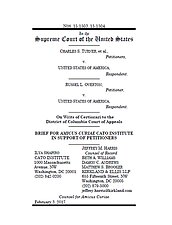Turner v. United States
Learn more about Cato’s Amicus Briefs Program.
Seven people were convicted of kidnapping, robbing, and murdering Catherine Fuller in 1984. Two eyewitnesses had told police that another person, James McMillan, had been at the scene of the crime acting suspiciously until he fled when police arrived. McMillian went on to murder another woman in a very similar manner after the trial. The prosecution failed to tell the defense of this other potential assailant, even though Brady v. Maryland (1963) requires the prosecution to inform the defense of all “evidence [that] is material either to guilt or to punishment.” The question is if these eyewitness accounts were material. The U.S. Court of Appeals for the D.C. Circuit found that because “what is at issue is the basic structure of how the crime occurred,” that to prevail, the defendants would need to show that the withheld evidence “would have led the jury to doubt virtually everything that the government’s eyewitnesses said about the crime.” “This makes the burden on appellants to show materiality quite difficult to overcome,” which burden the court said was not met here. The D.C. Circuit is wrong about what’s required under Brady, so Cato has filed an amicus brief urging the Supreme Court to review this case. If the evidence undermines the “basic structure of how the crime occurred,” that itself would make it material and thus subject to Brady disclosure. Instead of the threshold that the D.C. Circuit set, the proper threshold is the one that the Supreme Court set in Kyles v. Whitley(1995): evidence must be disclosed if it “undermines the confidence in the outcome of the trial.” If the D.C. Circuit’s standard is allowed to stand, it will undermine the prosecution’s incentives to disclose potentially exculpatory evidence. Sadly, Brady violations occur with troubling frequency all over the country. And given that they’re unlikely to be discovered because hidden from the defense, combined with the absolute immunity prosecutors typically enjoy if discovered, the lower court’s ruling here makes the situation even worse. It’s crucial for the protection of constitutional criminal procedure that the Supreme Court hear this case and reverse the artificially heightened materiality standard especially when the evidence undermines the government’s fundamental claim about how the crime occurred.
